Ok Steve. You weight your buildings below the grade, and I will weight mine higher. And we will all be happy.
And Ken, I don’t think I am in Kansas anymore.
Ok Steve. You weight your buildings below the grade, and I will weight mine higher. And we will all be happy.
And Ken, I don’t think I am in Kansas anymore.
Actually, up high is the worst place you can put it. Stability is simple, you have to keep the COG from crossing over the rotation axis.
Using the sailboat mentioned as an example. When the sail is up and the wind is blowing it is placing a lot of force on the boat, attempting to roll it over. If the weight was up high, it would carry the boat over once it crossed the boat’s rotation center line. You couldn’t put enough weight down below to counteract this without sinking the boat. That is why sailboats have a giant keel on them, they are moving the ballast well below the waterline to use leverage to their advantage. The combination of this keel and ballast keep the COG vs the rotation line of the boat in the proper location to keep it upright. This is of course as long as you don’t exceed the wind rating on the boat.
On a building on a layout, the building will want to rotate on the bottom of the downwind side. So if the wind is out of the South, the building will rotate on the bottom of the North side. Since the wind doesn’t blow out of one direction, you have to weight both sides. If the weight is up high, it will cross over the rotation point faster, and your building will become unstable faster. Therefore your weight needs to be low. Also, the faster the wind, the more weight you need. Now to be honest, our buildings really aren’t that big and the width is usually greater than the height. The greater the width to height ratio, the more stable your building will be on its own, which is why David’s method is working out for him.
And please, I’m not trying to start an argument. I’m a mechanical engineer and I deal with stability on a daily issue. This is what I design, an it has to be stable.
Chris

Yes, you don’t want the weight too high. Too high and the building becomes unstable. Of course the with to height ratio comes into play on where too high is.
A bit more to help visualize what I’m saying. I made an example of a building that is 9" wide by 18" tall. This is when stability will be a key factor. I placed weights, 1-1/2x3-1/2 down the length on both sides. For simplicity sake, we are going to say that the building and weights are the same materials.
First is weight low, with a 10 degree list. The dimension 6.869 represents the leverage the wind has to overcome to blow the building over. The greater this number, the less wind needed to tip it. The dimension 3.550 is the distance from the COG to the vertical tipping axis. The smaller this number, the less stable the building is.
Second example is the same set up at a 20 degree list. While worse, the building is still stable.
Now is the same building, same weights moved to the top. The first example is at 10 degree list. You will see the COG is closer to the vertical tipping axis than the previous example at twice the angle. Also the lever distance is twice the first example, meaning it will take half the wind speed to put this building in this condition.
Finally is the same example at a 20 degree list. You will notice the COG has crossed over the vertical tipping axis. This building is unstable and will go over.
I hope this helps out.
Chris
Not to change the subject, but moving along on the roof…
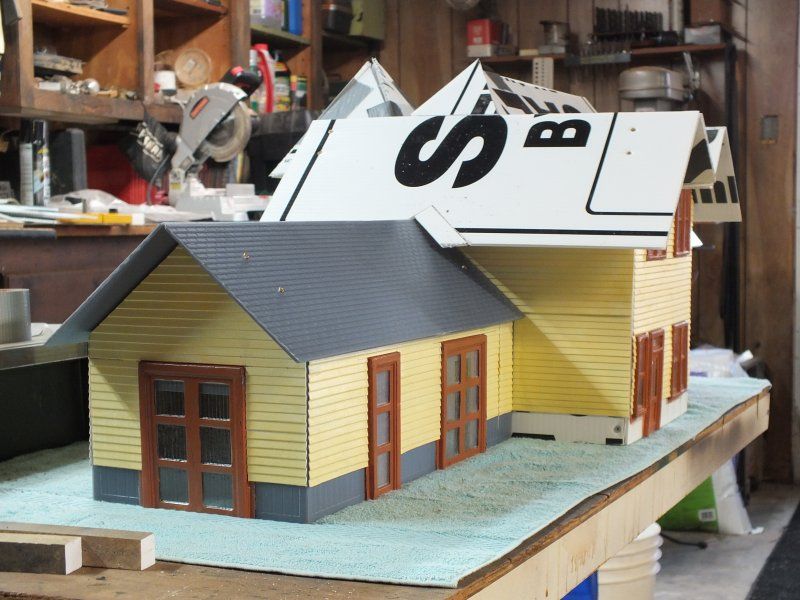
Got a few braces made for holding the roof together.
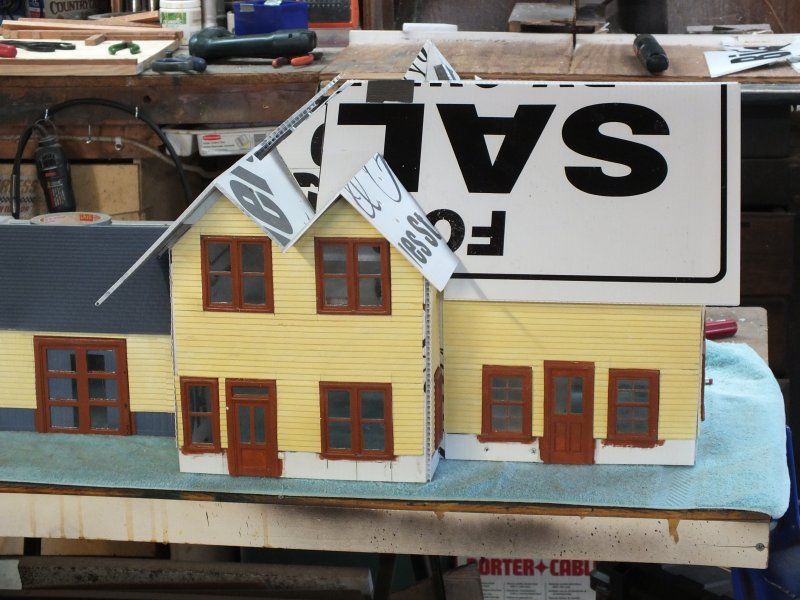
Still needs a few more under it to bring it together.
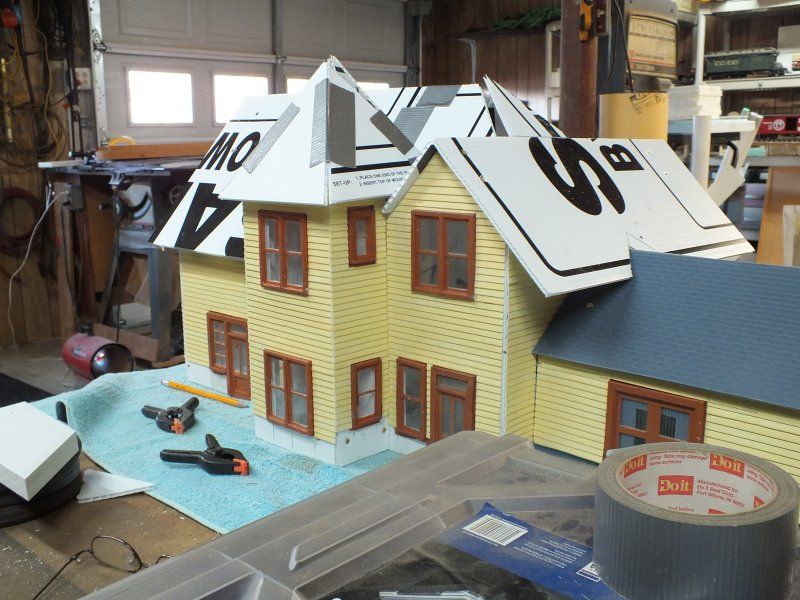
And a few gaps that need to be filled.
I bet that complicated roof is fun to build. Looking really good.
Chris
Chris Kieffer said:
I bet that complicated roof is fun to build. Looking really good.
Chris
You have no idea. I spend more time contemplating what I need to do than actual time doing it…(http://www.largescalecentral.com/externals/tinymce/plugins/emoticons/img/smiley-wink.gif)
Getting it lined up and tied all together is a real head scratcher, since I have to have on the building to keep it lined up. Hopefully I can get it to the point where it will lift off in one piece. We shall see…(http://www.largescalecentral.com/externals/tinymce/plugins/emoticons/img/smiley-wink.gif)
After much trial and error, the basic sub structure for the roof is about complete. Just need to start adding the roofing veneer. Don’t mind the chimineys, there just sitting there.
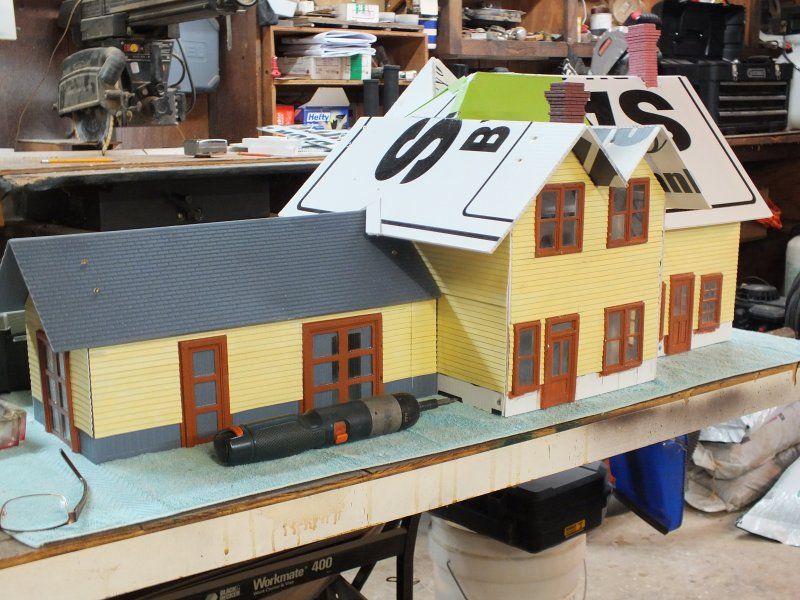
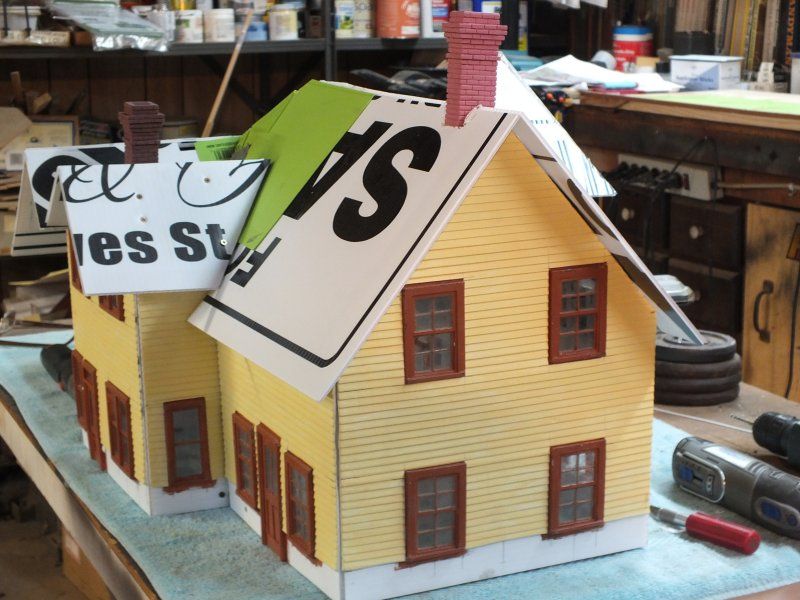
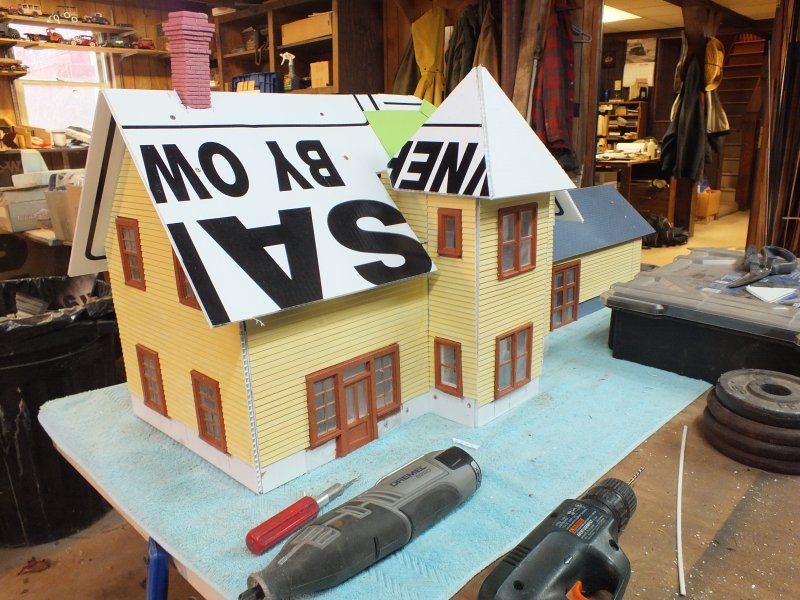
You don’t even want to see what the underside of that roof looks like…(http://www.largescalecentral.com/externals/tinymce/plugins/emoticons/img/smiley-wink.gif)
Looks good Ken. I want ask how many times you said &%^$^&
Too many times to count…(http://www.largescalecentral.com/externals/tinymce/plugins/emoticons/img/smiley-wink.gif)
It will be wonderful when it’s done. Just keep the progress photos coming, because they also inspire others to do projects. Ongoing projects keep the hobby alive in the minds of others who might need a little encouragement to continue. I particularly like that you used a cut up “For Sale By Owner” sign for the roof. Being in the realty business I don’t like people being stupid and trying to sell their own home. It is short-sighted and really costs more in the end.
Thanks Andrew.
I bught those signs from Lowes before I noticed the bigger, plain sheets of coroplast next to them…(http://www.largescalecentral.com/externals/tinymce/plugins/emoticons/img/smiley-wink.gif)
Ken Brunt said:
Don’t mind the chimineys, there just sitting there.
You don’t even want to see what the underside of that roof looks like…(http://www.largescalecentral.com/externals/tinymce/plugins/emoticons/img/smiley-wink.gif)
Gee, sounds a lot like my house. I mean, the one I live in. But a few years back I rebuilt the chimney, so its no longer just sitting there.
I haven’t seen any coroplst at my local Lowe’s, but I got a nice handfull of scraps from my home office when I was there. So I should be set for if and or when I start building stuff.
Looking good Ken. You are making progress there.
I found it where they sell the “For Rent” and “For Sale” signs. Those green pieces on the roof were also in the same location. I thought it was poster board at first but it’s thin styrene. If I’d have seen it sooner I would have used that stuff on the turntable pit walls instead if the “For Rent” signs, it’s a lot cheaper. The coroplast came in 2x3’ and 3x3’ sheets.
Looking good! That roof had to be a pain.
Ray Dunakin said:
Looking good! That roof had to be a pain.
You don’t know the half of it…
Lots of cutting and fitting and discarding when it don’t fit right.
But I am getting somewhere:
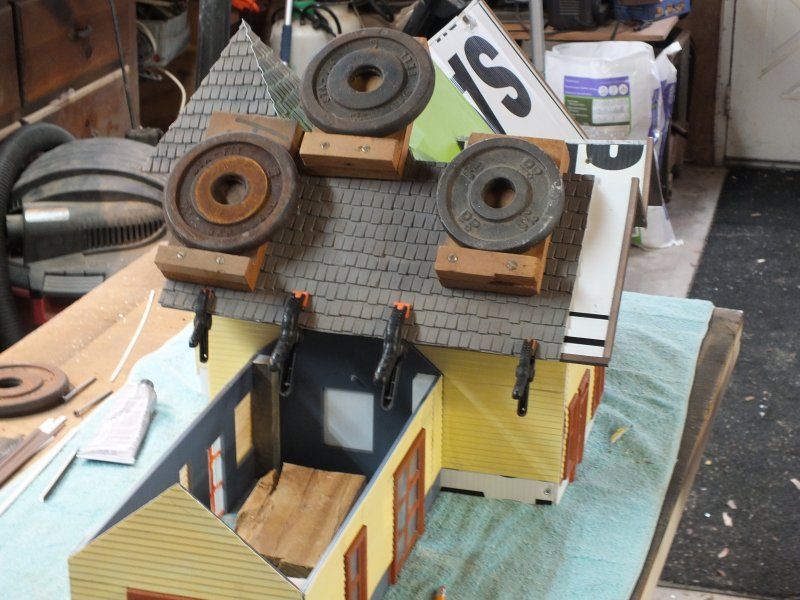
Slow and tedious, but progress is steady.

Finally got the tower roof lined up right. It was a bit cattywhompus and since I needed the main roof attached, it was difficult seeing what the hang up was.
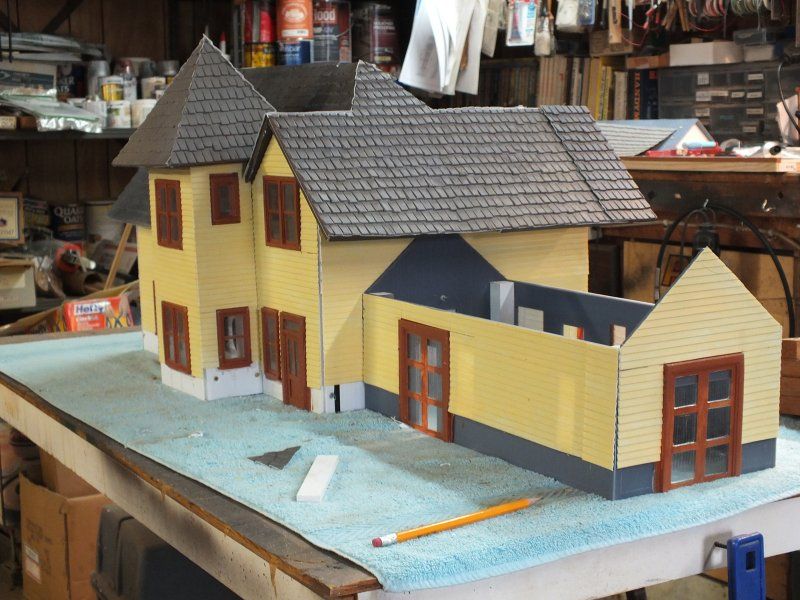
Still a bit more to do on this side.
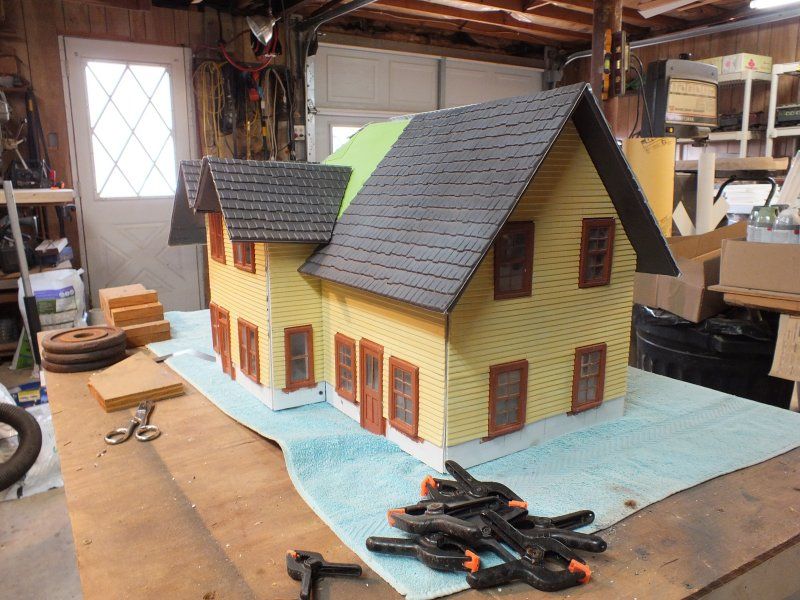
But, for just going by pictures of the place, it’s coming along fairly well.
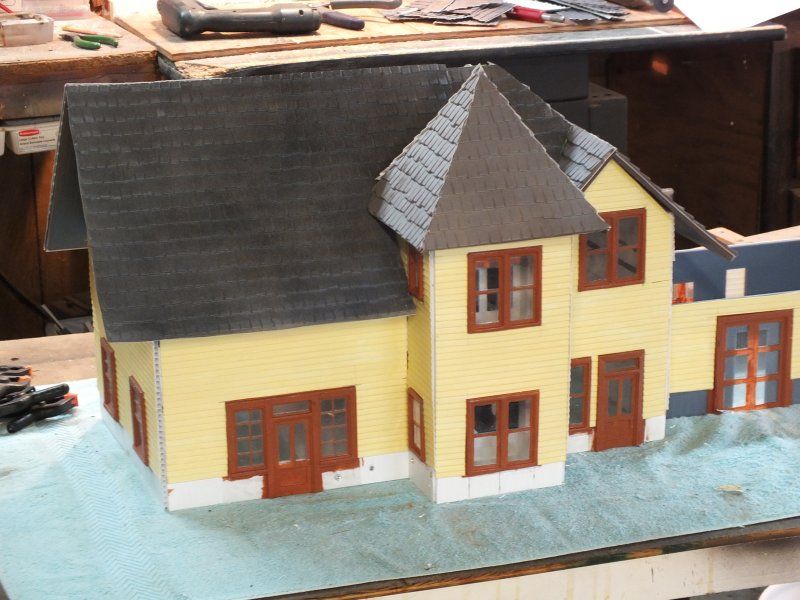
I find that Morrison & Boyd’s Organic Chemistry (or any other FAT book) opened up to the halfway point and set over the roof also works well for this chore.
Yea, Todd, I’ve done that a time or two. I had made these up for clamping something together, a long time ago, so I kinda re-purposed them…(http://www.largescalecentral.com/externals/tinymce/plugins/emoticons/img/smiley-wink.gif)
Ken, what kind of stuff is that for the roofing shingles and where did you get it? I have a few roofs need repairing/replacing.
That’s this stuff, Lou:
http://www.ozarkminiatures.com/scripts/prodView.asp?idproduct=12346
from Ozark.
Plastruct has it too, only thinner and a bit more expensive. I’m going to use the Plastruct stuff on the curved porch roof since it’s a lot more flexible.(almost rubbery)
https://plastruct.com/shop/plain-and-patterned-sheet/91644-ps-134l/